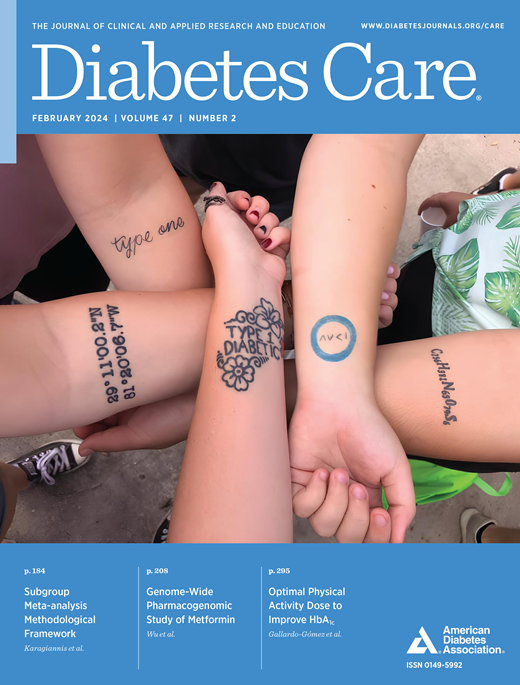替西肽降低2型糖尿病患者早期空腹血糖或体重和代谢结局:一项对transcend试验的事后分析
IF 16.6
1区 医学
Q1 ENDOCRINOLOGY & METABOLISM
引用次数: 0
摘要
目的评价晚期(40周或42周;在接受替西肽治疗的2型糖尿病患者的早期血糖反应(第4周空腹血糖[FSG]降低20%或≥20%)或体重反应(第8周体重降低5%或≥5%)的代谢结果,分别为第40/42周。研究设计和方法本事后分析采用了跨试验的汇总数据。基线特征,从基线到第40/42周的疗效参数变化,胃肠道(GI)不良事件(ae)通过FSG (SURPASS-1至-4;n = 3,676)或重量(SURPASS-1至-5;N = 4121),分别在疗效和安全性分析集中。结果:FSG的早期应答者(50%)较年轻,血糖参数较高,基线体重较低。体重的早期应答者(31%)在基线时血糖参数和体重较低,女性和白人的比例更高。FSG或体重的早期应答者和非早期应答者在第40/42周获得了更好的HbA1c(分别为- 2.6% vs. - 2.0%或- 2.5% vs. - 2.2%)和体重(分别为- 11% vs. - 10%或- 15% vs. - 8%)应答,血压和血脂谱也有更大的改善。非早期应答者在所有替西帕肽剂量下均有临床意义的HbA1c和体重下降。胃肠道不良事件(一般为轻度至中度事件)的发生率随着时间的推移而下降,并且在早期和非早期应答者之间一般具有可比性。结论:替西肽的早期血糖和体重反应与较好的长期代谢结果相关。早期反应可能是一个很好的临床指标,可以帮助告知个体化治疗以达到治疗目标。本文章由计算机程序翻译,如有差异,请以英文原文为准。
Early Fasting Serum Glucose or Weight Reduction With Tirzepatide and Metabolic Outcomes in People With Type 2 Diabetes: A Post Hoc Analysis of the SURPASS Trials
OBJECTIVE To evaluate late (week 40 or 42; hereafter, week 40/42) metabolic outcomes by early glycemic response (<20% or ≥20% fasting serum glucose [FSG] reduction at week 4) or weight response (<5% or ≥5% weight reduction at week 8), respectively, in tirzepatide-treated participants with type 2 diabetes in the SURPASS trials. RESEARCH DESIGN AND METHODS This post hoc analysis used pooled data across trials. Baseline characteristics, change from baseline to week 40/42 for efficacy parameters, and gastrointestinal (GI) adverse events (AEs) were described and analyzed by early response in terms of FSG (SURPASS-1 to -4; n = 3,676) or weight (SURPASS-1 to -5; n = 4,121) in the efficacy and safety analysis set, respectively. RESULTS Early responders in FSG (50%) were younger, with higher glycemic parameters and lower weight at baseline. Early responders in weight (31%) had lower glycemic parameters and weight at baseline, and a greater percentage were women and White. Early versus nonearly responders in FSG or weight achieved better HbA1c (−2.6% vs. −2.0% or −2.5% vs. −2.2%, respectively) and weight (−11% vs. −10% or −15% vs. −8%, respectively) responses at week 40/42 and greater improvements in blood pressure and lipids profile. Nonearly responders also had clinically meaningful HbA1c and weight reductions with all tirzepatide doses. The incidence of GI AEs (generally mild to moderate events) decreased over time and was, in general, comparable between early and nonearly responders. CONCLUSIONS Both early glucose and weight responses with tirzepatide were associated with better longer-term metabolic outcomes. Early response may be a good clinical indicator that could help inform treatment individualization to achieve therapeutic goals.
求助全文
通过发布文献求助,成功后即可免费获取论文全文。
去求助
来源期刊

Diabetes Care
医学-内分泌学与代谢
CiteScore
27.80
自引率
4.90%
发文量
449
审稿时长
1 months
期刊介绍:
The journal's overarching mission can be captured by the simple word "Care," reflecting its commitment to enhancing patient well-being. Diabetes Care aims to support better patient care by addressing the comprehensive needs of healthcare professionals dedicated to managing diabetes.
Diabetes Care serves as a valuable resource for healthcare practitioners, aiming to advance knowledge, foster research, and improve diabetes management. The journal publishes original research across various categories, including Clinical Care, Education, Nutrition, Psychosocial Research, Epidemiology, Health Services Research, Emerging Treatments and Technologies, Pathophysiology, Complications, and Cardiovascular and Metabolic Risk. Additionally, Diabetes Care features ADA statements, consensus reports, review articles, letters to the editor, and health/medical news, appealing to a diverse audience of physicians, researchers, psychologists, educators, and other healthcare professionals.
 求助内容:
求助内容: 应助结果提醒方式:
应助结果提醒方式:


